The last flight of Meteor RA 376
written in memory of Pilot Officer John Kidd
In the summer
of 1952, Meteor MK 4 serial number RA 376, was based at RAF Finningley, and
was one of the aircraft used by 215 AFS (advanced flying school). On Monday
11th August at about 12.30 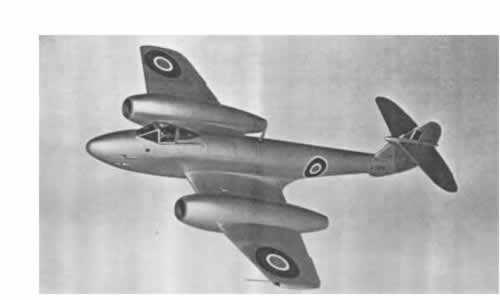 this aircraft took off for the start of a training exercise. Alongside
was another Meteor, a two seat T7, being flown by the course instructor and
carrying another student pilot. The two aircraft took off wing tip to wing
tip in a southerly direction along the main runway. The stated intention that
morning, was to carry out a formation flying exercise (ex32), above 2000ft.
The aircraft had been cleared for such an exercise, as the weather conditions
had improved during the morning and the prediction was that this improvement
would continue. The previous week of August had seen unsettled weather and
a rain shower had crossed the airfield at midday. The pair climbed away from
the airfield towards the cloud base at 1500 ft. As the instructor was about
to enter cloud he noticed that his student in the MK4 had fallen behind and
below. The pair were not in radio communication at this point, however, he
entered cloud and emerged above to wait for his student to appear alongside,
then the exercise could begin.
this aircraft took off for the start of a training exercise. Alongside
was another Meteor, a two seat T7, being flown by the course instructor and
carrying another student pilot. The two aircraft took off wing tip to wing
tip in a southerly direction along the main runway. The stated intention that
morning, was to carry out a formation flying exercise (ex32), above 2000ft.
The aircraft had been cleared for such an exercise, as the weather conditions
had improved during the morning and the prediction was that this improvement
would continue. The previous week of August had seen unsettled weather and
a rain shower had crossed the airfield at midday. The pair climbed away from
the airfield towards the cloud base at 1500 ft. As the instructor was about
to enter cloud he noticed that his student in the MK4 had fallen behind and
below. The pair were not in radio communication at this point, however, he
entered cloud and emerged above to wait for his student to appear alongside,
then the exercise could begin.
Gloster Meteor Mk 4
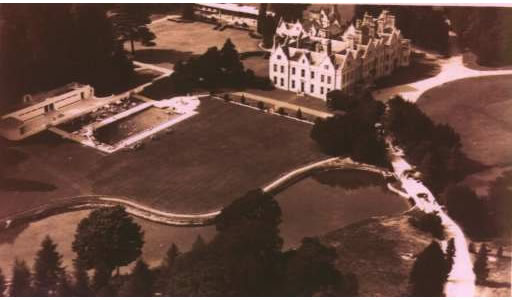 Firbeck
Hall is about 15km south of Finningley, and the building and the grounds
were then being used as a miners rehabilitation hospital. The hall was surrounded
by several collieries of the North Nottinghamshire and South Yorkshire coalfields,
and its use was now a world away from the exclusive country club of the 1930's.
Freda Armstrong worked within the administration of the hospital, and had
decided to spend some of her lunch break on the putting green. It was a pleasant
August day, and the putting green represented an ideal opportunity to relax
before the work of the afternoon. She was suddenly distracted by the noise
of a jet aircraft which passed rapidly and low overhead, she watched it disappear
over the woods in the direction of Letwell, then moments later heard the sound
of an explosion and saw a column of black smoke rising from the distance.
Freda made her way to the hospitals' telephone and placed an emergency call
with the local police, who confirmed that they had already received reports
of an aircraft crashing.
Firbeck
Hall is about 15km south of Finningley, and the building and the grounds
were then being used as a miners rehabilitation hospital. The hall was surrounded
by several collieries of the North Nottinghamshire and South Yorkshire coalfields,
and its use was now a world away from the exclusive country club of the 1930's.
Freda Armstrong worked within the administration of the hospital, and had
decided to spend some of her lunch break on the putting green. It was a pleasant
August day, and the putting green represented an ideal opportunity to relax
before the work of the afternoon. She was suddenly distracted by the noise
of a jet aircraft which passed rapidly and low overhead, she watched it disappear
over the woods in the direction of Letwell, then moments later heard the sound
of an explosion and saw a column of black smoke rising from the distance.
Freda made her way to the hospitals' telephone and placed an emergency call
with the local police, who confirmed that they had already received reports
of an aircraft crashing.
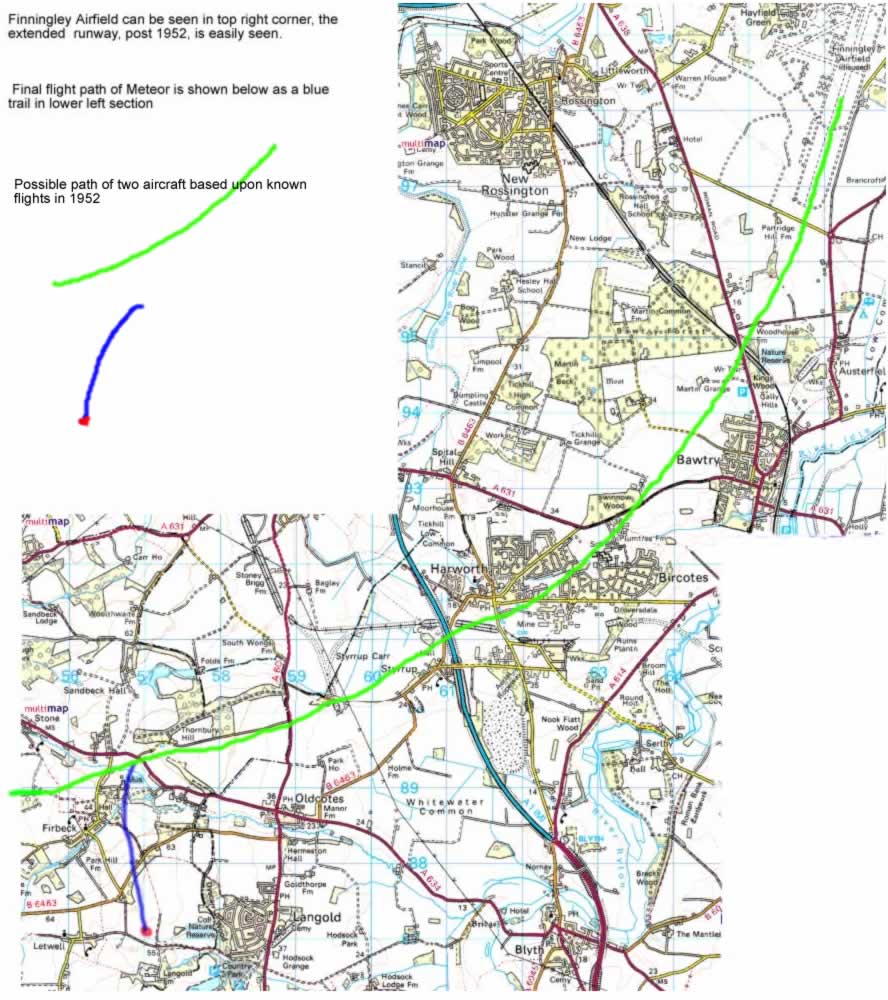
Shown above is a current map of the area, onto which has been superimposed a possible flight path of the two aircraft. The green line traces a line that could have been taken by by the aircraft, and is intended to show the relative positions of the airfield and the crash site.
The main runway of Finningley airfield was extended in the years after the accident, when the base became an OCU for Vulcan bombers.
Firbeck and Firbeck Hall can be seen in the lower corner, together with the known route of the Meteor which has been marked in blue.
Langolds landscaped colliery waste heap shows behind the trees
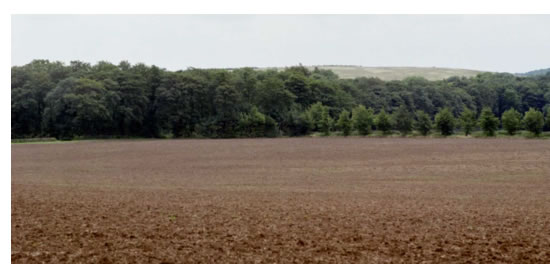 On the right, is the pea
field where the crash happened. The photograph was taken on its 50th anniversary,
the peas had been harvested mechanically about a month earlier, leaving the
rather Autumnal brown appearance which is unusual for August. 50 years ago
the same field was being harvested of peas by 150 women and girls, who were
working in the immediate area of the camera. The Meteor came in from the left
of the frame and impacted within the shallow depression seen in the centre
frame, about 100m from the line of young trees that form on either side of
a farm road. The wreckage was scattered forward into the mature trees seen
in the distance, as well as into the field on the other side of the farm road.
A field that was being harvested.
On the right, is the pea
field where the crash happened. The photograph was taken on its 50th anniversary,
the peas had been harvested mechanically about a month earlier, leaving the
rather Autumnal brown appearance which is unusual for August. 50 years ago
the same field was being harvested of peas by 150 women and girls, who were
working in the immediate area of the camera. The Meteor came in from the left
of the frame and impacted within the shallow depression seen in the centre
frame, about 100m from the line of young trees that form on either side of
a farm road. The wreckage was scattered forward into the mature trees seen
in the distance, as well as into the field on the other side of the farm road.
A field that was being harvested.
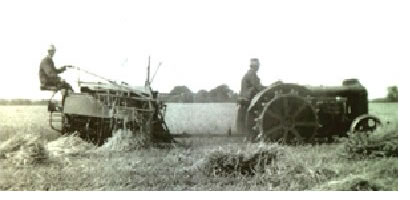 It was in this
field that two farm workers, Royce Priestley, the tractor driver and Ron Spencer
the binder operator, were harvesting corn. The outfit had been standing idle
before crash, having suffered a mechanical problem. Ron Spencer, who was 23
years old at the time, remembers the day as warm and sunny and he had his
shirt sleeves rolled. He told of how he was attracted by the whistle of the
jet as it approached, at low level from over the woods in the distance and
then across the pea field opposite. It seemed that the aircraft would land
in the field, and his immediate reaction was to start to move towards it.
This reaction rapidly changed to one of self preservation, as the aircraft
impacted then broke up and a shower of wreckage came towards him. He and Royce
took shelter behind the tractor where they heard and saw pieces of metal zipping
through the air above and about them. Ron recalls the fact that one of the
jets main wheels had landed just a few metres away from him, and he still
owns a faded press cutting that shows a picture of him crouching alongside
this wheel. 100m away in the pea field , the jet had scraped out a shallow
crater "12 yds long and 8 yds wide". After the impact the fuel in the meteor
caught fire the main body of the jet and its full load of fuel were burning
generating a large volume of black smoke.
It was in this
field that two farm workers, Royce Priestley, the tractor driver and Ron Spencer
the binder operator, were harvesting corn. The outfit had been standing idle
before crash, having suffered a mechanical problem. Ron Spencer, who was 23
years old at the time, remembers the day as warm and sunny and he had his
shirt sleeves rolled. He told of how he was attracted by the whistle of the
jet as it approached, at low level from over the woods in the distance and
then across the pea field opposite. It seemed that the aircraft would land
in the field, and his immediate reaction was to start to move towards it.
This reaction rapidly changed to one of self preservation, as the aircraft
impacted then broke up and a shower of wreckage came towards him. He and Royce
took shelter behind the tractor where they heard and saw pieces of metal zipping
through the air above and about them. Ron recalls the fact that one of the
jets main wheels had landed just a few metres away from him, and he still
owns a faded press cutting that shows a picture of him crouching alongside
this wheel. 100m away in the pea field , the jet had scraped out a shallow
crater "12 yds long and 8 yds wide". After the impact the fuel in the meteor
caught fire the main body of the jet and its full load of fuel were burning
generating a large volume of black smoke.
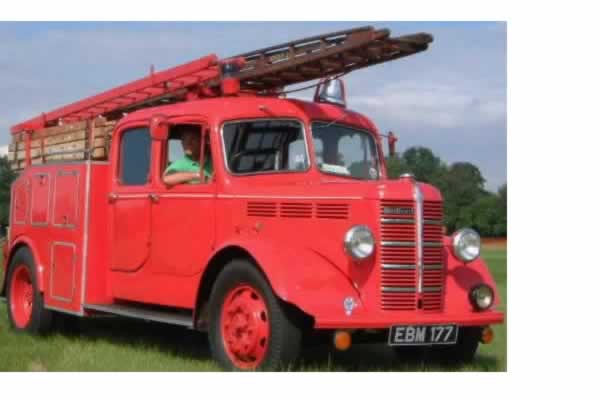 The
time was now about 12 .40pm, and calls were being received by the local police,
informing them of the crash. They passed on the message to the fire service
and an appliance operated by the volunteer fire service at Kiveton Park, was
one of those called to the scene.
The
time was now about 12 .40pm, and calls were being received by the local police,
informing them of the crash. They passed on the message to the fire service
and an appliance operated by the volunteer fire service at Kiveton Park, was
one of those called to the scene.
I was a seven year old school boy, waiting for the 1o'clock bus in the neighbouring village of Dinnington, and I can still recall the red Bedford fire engine racing into the village with its bell clanging furiously, then watching it disappear along Doe Quarry Lane in the direction of Letwell. That evening I found out it was a Meteor that had crashed and that the pilot had been killed. More than 49 years later, after a chance reference to this accident, I decided to try to find the site of the crash.
The following pages give an account of that research. I had hoped to find the actual site and perhaps the name of the pilot. I did discover far more than I ever envisaged that I would and this was due to numerous people who took the time and the trouble to help me. Their interest into my revealing the story of what had happened was most encouraginging, and without it I doubt that I would have persevered with the task.